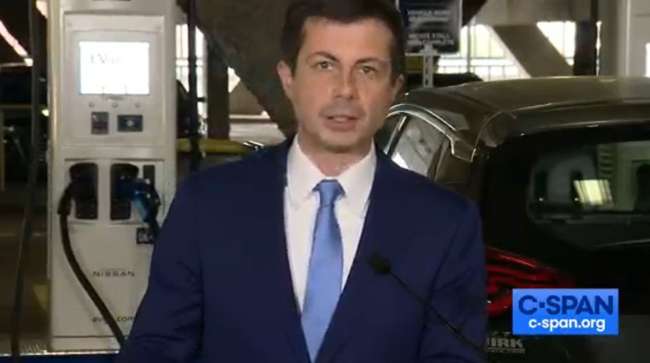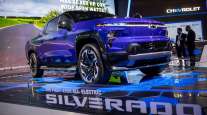Staff Reporter
Secretary Pete Buttigieg Unveils New Alternative Fuel Corridor Designations

[Stay on top of transportation news: Get TTNews in your inbox.]
Transportation Secretary Pete Buttigieg announced a new round of Alternative Fuel Corridor designations as part of the Biden administration’s push to advance electric vehicle charging infrastructure.
The Federal Highway Administration’s Alternative Fuel Corridors program recognizes highway segments that have infrastructure (or plans for infrastructure) that support alternative fuel options. The program charts sources of various alternative fuels, including electricity, compressed natural gas, liquefied petroleum gas and hydrogen.
Buttigieg made the announcement April 22, linking the acknowledgment of Earth Day to the administration’s emphasis on a clean transportation future. He spoke at a press conference held in front of EV charging equipment located near Union Station and noted the transportation sector is the largest source of greenhouse gas emissions.
EV Funding Report 2021 by Transport Topics on Scribd
“That relationship to the problem of climate change means that we in transportation can also be the biggest part of the solution,” Buttigieg said. “The solution clearly includes zero-emissions vehicles and charging stations.”
The Round 5 Alternative Fuel Corridors designated “corridor-ready” by FHWA encompass stretches of roads in 27 states. Corridor-ready means EV charging stations are located no more than 50 miles apart and no more than 5 miles off the highway. According to the Round 5 list, compressed natural gas options are available near U.S. Route 61 in Iowa. Virginia has EV infrastructure near state borders along interstates 81 and 95. Points along various interstates in Arizona are classified as liquefied petroleum gas-ready.
The first five rounds of designations represent options along 134 interstates and 125 U.S. highways and state roads, covering approximately 165,722 miles of the National Highway System. Of that figure, FHWA has designated EV corridors on 58,980 miles of the system in 48 states and Washington, D.C. South Dakota and Mississippi are the only states lacking an EV corridor designation.
“These routes, which connect communities large and small, signal the clear demand for cleaner, more affordable transportation across the country,” Buttigieg said.
Also on April 22, the Department of Transportation released a report containing guidance on how federal grants can be used to deploy charging infrastructure. Many existing programs, including the Advanced Transportation and Congestion Management Technologies Deployment program and the Infrastructure for Rebuilding America (INFRA) program, have EV eligibilities.
According to the report, as of April 2021, there were approximately 38,000 publicly accessible, non-Tesla EV charging stations.
Other agencies besides DOT announced actions to accelerate EV and charging initiatives April 22. The General Services Administration announced it has made progress on the goal to transition the federal fleet to zero-emissions vehicles. The Department of Energy announced new funding and partnerships meant to support charger-related research and development. Some $20 million will help accelerate the adoption of commercially available plug-in electric vehicles and related infrastructure through public-private partnerships in communities.
The Biden administration has set of goal of building 500,000 new public EV chargers by 2030. As well as reducing greenhouse gas emissions, these stations are meant to generate jobs.
“Creating jobs and addressing climate change are not contrary ideas,” said National Climate Advisor Gina McCarthy, who also spoke at the press conference. “They actually go together hand in hand.”
Want more news? Listen to today's daily briefing below or go here for more info:




